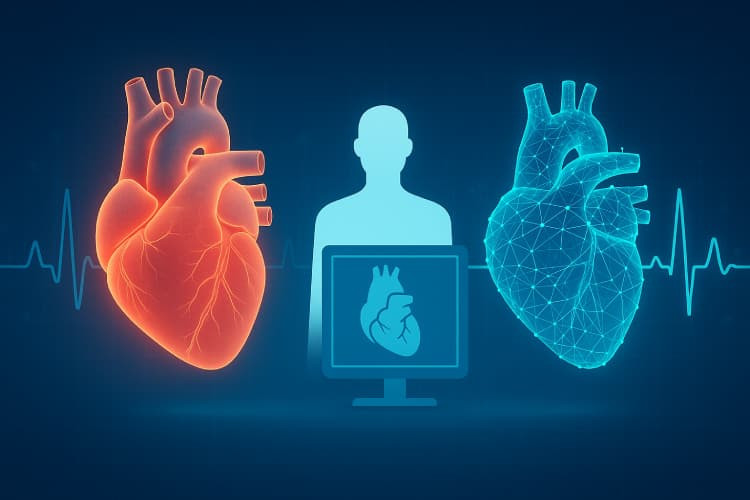Digital Twins of Human Heart Improve Disease Modelling
Insights | 02-07-2025 | By Robin Mitchell

Key Takeaways:
- UK researchers have created nearly 4,000 digital heart twins using real patient imaging and ECG data—offering new insights into how age, sex, and BMI affect heart function.
- Machine learning and surrogate modelling significantly reduced simulation time, enabling personalised cardiac models to be generated in minutes instead of hours.
- These digital twins accurately replicate key heart metrics such as QRS duration and QT intervals, enhancing risk prediction and clinical decision-making for heart conditions.
- Validated against real-world data, the models show strong correlation with recorded ECGs—supporting their future role in scalable, AI-driven clinical research.
Digital twins have emerged as powerful tools across engineering and manufacturing, offering real-time simulations rooted in real-world data. In medicine, the idea of creating a virtual copy of a human organ, capable of being tested and analysed without ever touching a patient, is both thrilling and daunting. But while the concept holds immense potential, the biological complexity of the human body presents formidable challenges.
What makes digital twins in medicine so difficult to realise? What breakthrough have UK researchers achieved in developing thousands of digital hearts? And how might this change the future of healthcare and clinical research?
The Challenges With Digital Twins in Medicine
Over the past decade, the term digital twin has gained monumental attention due to their ability to provide engineers with valuable insight into a system and how it responds to its environment. But what exactly is a digital twin, and how does it differ from a simulation?
At their core, a digital twin is really just a highly detailed simulation tied directly to real-world data. For example, a digital twin of a wind turbine isn't just any simulation. It's a model built on actual data streamed from a specific turbine in the field. This twin reflects real-time conditions and past performance, allowing engineers to run tests on the virtual model to predict how the physical turbine will behave under different scenarios. That's the big difference from your run-of-the-mill simulation; digital twins operate on live data to provide a more accurate, responsive picture.
From Industrial Assets to Human Organs: Digital Twins Enter Medicine
Now, digital twins are creeping into just about every industry, but medicine is where they really get interesting. Imagine a digital twin of a human organ. In theory, you could test new drugs, run long-term studies, or uncover causal relationships in disease without ever touching a patient. Sounds promising, right?
Sadly, organs aren't machines. They're complex, multicellular systems with layers of biological nuance we're only beginning to understand. Creating a digital twin that accurately models this complexity is borderline impossible with today's technology. Cells don't behave like predictable gears in a machine; they respond to countless chemical, electrical, and environmental cues that vary constantly and often unpredictably.
On top of that, biological variability between individuals makes it even harder. What happens inside one person's liver or heart under certain conditions might differ wildly from another's. Capturing this variability in a single model? That's a monumental challenge.
So while the idea of digital twins in medicine holds massive potential, the reality is that we're still scratching the surface. These models can complement research, sure, but are they expected to replace real clinical trials or fully predict human biology any time soon? Well, that is highly unlikely, or is it?
UK Scientists Create Thousands of Digital Twins of Hearts in Groundbreaking Research
A team of UK researchers from King's College London, Imperial College, and The Alan Turing Institution has successfully created nearly 4,000 anatomically accurate digital hearts in a major breakthrough for the field of medical research. The digital twins, which are computer models that simulate the heart's function, have been designed to help researchers better understand the factors that contribute to heart disease and how it can be treated.
Crucially, the use of surrogate modelling and Gaussian process emulators reduced the computational time required to generate each digital twin. What once took hours now takes minutes, making it feasible to personalise cardiac simulations at scale, a key enabler for large-cohort studies and potential integration into routine clinical practice.
Unlocking Population-Level Insights from Personalised Heart Models
By analysing over 3,500 digital heart models, the study identified key physiological differences in how age, sex, and body weight influence heart conduction. For instance, it was found that males generally have longer QRS durations due to larger myocardial mass, while females exhibit lower potassium conductance, which extends the QT interval. These insights provide a more refined basis for understanding cardiovascular risk profiles beyond traditional ECG readings.
According to the researchers, the digital twins were created using real patient data and electrocardiogram (ECG) readings from both the UK's Biobank and a cohort of patients with existing heart conditions. The use of patient data allows the digital twins to be highly accurate, as they are based on real measurements taken from real patients. The researchers have stated that the digital twins will help to refine treatments and identify new targets for heart disease prevention.
The team used a biophysically detailed modelling approach to replicate electrocardiogram intervals, such as QRS duration and QTc, with high fidelity. This allows researchers to separate structural factors like heart size from biological ones such as conduction velocity and ion channel behaviour, delivering a clearer picture of cardiovascular function across diverse patient demographics.
Machine Learning Accelerates Precision in Cardiac Modelling
The development of digital twins was made possible thanks to recent advances in machine learning algorithms and artificial intelligence. The use of these technologies allows for the creation of digital twins at a much faster rate than previously possible, thereby making the technology more accessible to researchers. Furthermore, the creation of digital twins at scale will allow researchers to identify patterns in heart function that would otherwise be difficult to spot.
The models were validated through correlation with real-world ECG data, showing up to 87% alignment in electrical dipole magnitudes and minimal deviation in vector orientations. This level of agreement reinforces confidence in the model's clinical relevance and potential future role in pre-screening for conditions such as heart failure or conduction blocks.
Could Digital Twins Transform the Medical Industry?
Let's not mince words: if fully viable digital twins of human organs become a reality, it would rank as one of the most transformative breakthroughs in human history, right up there with the invention of the transistor. That's not hyperbole. The potential impact on medicine is just that monumental.
Currently, medical research faces a slew of challenges. Running large-scale clinical studies on actual patients is fraught with problems. Finding enough suitable candidates and control groups to produce reliable data is a logistical nightmare. Add to that the ethical minefield of testing on live humans, and you quickly see why progress can be agonisingly slow.
Even when you get past those hurdles, controlling variables in real life is nearly impossible. Environmental factors, genetics, and lifestyle all throw wrenches into identifying true cause and effect. It's like trying to fix a car while it's speeding down the highway.
Now, imagine if live patients could be replaced, or at least supplemented, by their digital twins. These aren't just simulations; they're dynamic, data-driven models tightly linked to real-world biology. Suddenly, the scale of experiments is limited only by your computing power. Need a trial with a million "patients"? No problem, fire up the servers.
The implications are staggering. Faster drug development, clearer understanding of disease causation, and more efficient screening for side effects. Even more exciting: the rise of artificial organs designed and tested virtually before ever stepping into a lab, surgical procedures rehearsed in silico, and prescriptions tailored to predicted patient outcomes.
Sure, we're not quite there yet. The complexity of biological systems is massive, and models still have gaps. But the direction is clear. Digital twins could redefine how medicine is practised, speeding up innovation while reducing costs and risks.
As an engineer, I find this intersection of computation and biology fascinating. The potential to crunch petabytes of data to save lives, not just diagnose symptoms, is the future. And frankly, it's about time medicine got as serious about precision and scale as the tech industry has.

